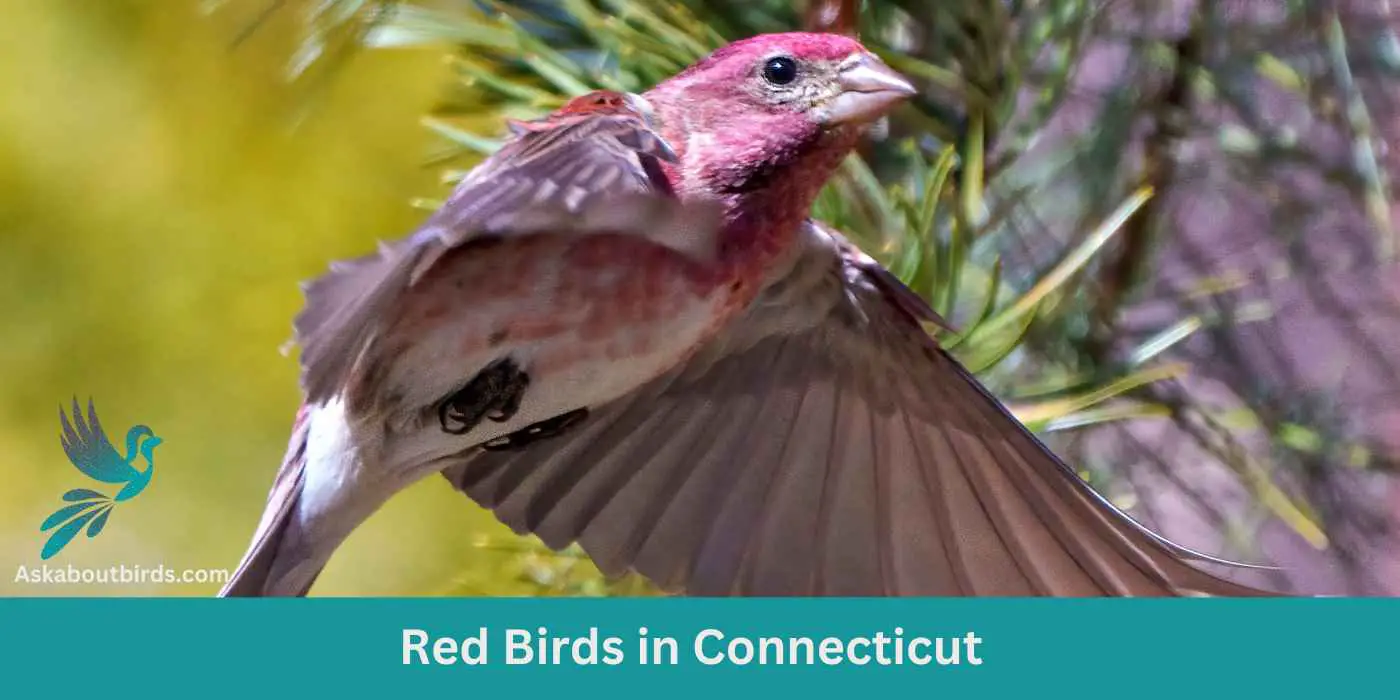Discover the vibrant hues of avian life in the Nutmeg State! Our guide to the “9 Red Birds In Connecticut” not only showcases these crimson-feathered wonders but also offers you a complimentary photo guide to make your birdwatching adventures even more rewarding.
Whether you’re a seasoned birder or just beginning your journey, Connecticut’s scarlet skies await your exploration. Dive in and let these winged marvels paint your day with shades of red.
Red Birds Found In Connecticut
Positioned in the heart of the Atlantic Flyway, Connecticut provides a critical corridor for migratory birds, making it a hotspot for avian biodiversity. Its diverse habitats, ranging from coastal marshes to inland hardwood forests and freshwater wetlands, offer suitable nesting and feeding grounds for a plethora of bird species.
Northern Cardinal


| Feature | Measurement |
|---|---|
| Scientific Name | Cardinalis cardinalis |
| Length | 8.3 – 9.1 in |
| Wingspan | 9.8 – 12.2 in |
| Weight | 1.19 – 2.29 oz |
The Northern Cardinal is an iconic North American bird, easily recognized by its vibrant color and melodious song.
Appearance: Male Northern Cardinals are a brilliant scarlet red, while females display a more subdued reddish olive. Both sexes have a distinctive black ‘mask’ on their face around the bill and a pointed crest on their head. The bird’s beak is robust, cone-shaped, and bright orange in color.
Diet: Northern Cardinals are primarily granivorous, with a diet largely consisting of seeds and grains. They also eat fruits and insects. These birds typically feed off the ground and are frequent visitors to bird feeders.
Reproduction: Northern Cardinals are monogamous, and a pair will breed together for life. The female typically builds a well-hidden nest in a dense thicket or shrub. She lays 2-5 eggs per clutch, which she incubates for around two weeks.
Red-Winged Blackbird
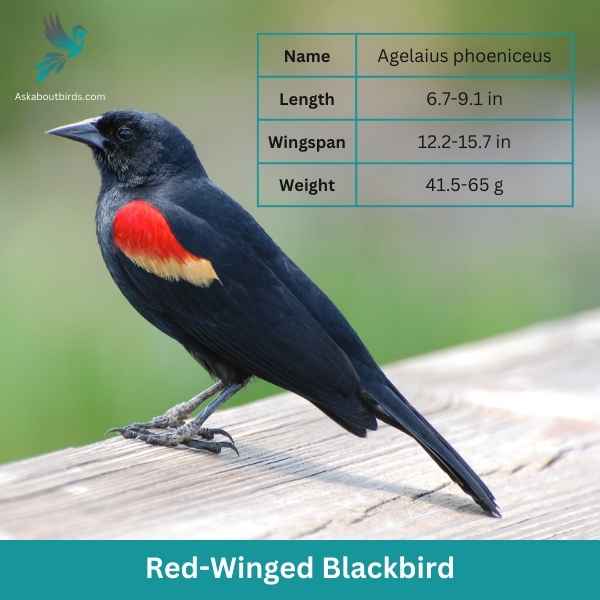
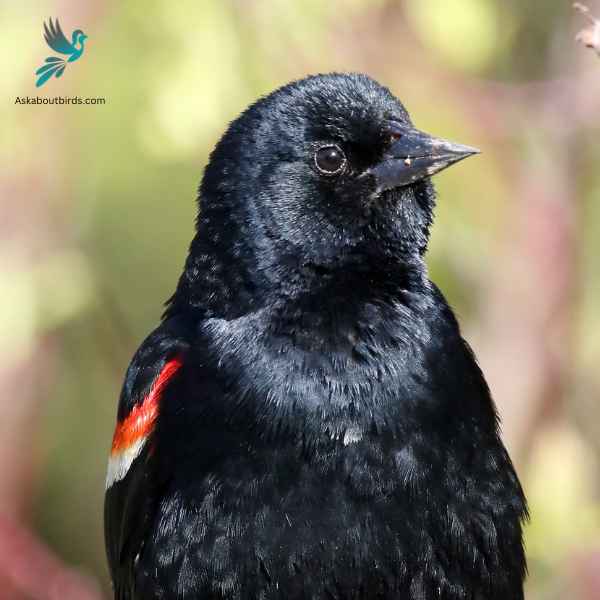
| Feature | Measurement |
|---|---|
| Scientific Name | Agelaius phoeniceus |
| Length | 6.7-9.1 in |
| Wingspan | 12.2-15.7 in |
| Weight | 41.5-65 g |
The Red-Winged Blackbird is a familiar sight across North America, especially in wetlands and open areas. Known for its striking coloration and distinct call, it is often seen perched on cattails or utility lines.
Appearance: Male Red-Winged Blackbirds are glossy black with bright red-and-yellow shoulder patches, while females are streaky brown, resembling a large sparrow. The males’ red patches become more prominent when they’re displaying or agitated.
Diet: Red-Winged Blackbirds primarily feed on seeds and insects. Their diet includes grains, sunflower seeds, and corn, but they also eat beetles, caterpillars, and other small invertebrates, especially in the breeding season.
Reproduction: Red-Winged Blackbirds nest in marshes, along watercourses, and in wet fields. The female constructs a cup-shaped nest using grass and sedge, attaching it to plants above water. She typically lays a clutch of 3 to 4 blue-green eggs, which she incubates for about 11-12 days. Males, being polygynous, often have multiple mates during a single breeding season.
House Finch


| Feature | Measurement |
|---|---|
| Scientific Name | Haemorhous mexicanus |
| Length | 5–6 in |
| Wingspan | 8–10 in |
| Weight | 0.6–0.9 oz |
The House Finch is a small songbird widely distributed across North America and is commonly found in urban and suburban areas.
Appearance: Males of this species are brightly colored with crimson faces and throats, which can extend to the chest and back, while their flanks have streaks. The female is streaked brown and lacks the red coloring. Both have a square-tipped tail and a distinctively long, flat-topped bill.
Diet: House Finches primarily eat seeds, grains, and berries. They have a particular fondness for sunflower seeds and can be commonly seen at bird feeders. Occasionally, they will also consume insects, especially during the breeding season.
Reproduction: House Finches are cavity-nesters and might choose ledges, vents, ledges, and other urban settings. They might also utilize trees or shrubs. Their nests can be made of a wide array of materials, from feathers to twigs.
Scarlet Tanager


| Feature | Measurement |
|---|---|
| Scientific Name | Piranga olivacea |
| Length | 6.3 to 7.5 in |
| Wingspan | 9.8 to 11.8 in |
| Weight | 23.5 to 38 g |
The Scarlet Tanager is a strikingly colorful bird known for its brilliant plumage and distinctive song.
Appearance: Male Scarlet Tanagers are notable for their vibrant scarlet bodies contrasted with black wings and tail, making them one of the most intensely colored birds. Females and juveniles, on the other hand, have a subdued olive-yellow body color with darker wings and tail.
Diet: The diet of the Scarlet Tanager is largely made up of insects, including beetles, cicadas, aphids, and others. They are adept flycatchers, seizing insects in mid-air or picking them off foliage. They also consume fruits and berries, especially during migration and in their winter habitats.
Reproduction: The female Scarlet Tanager builds a cup-shaped nest using twigs, rootlets, and grass, typically well-hidden in the dense foliage of trees. She lays 3 to 5 eggs and incubates them for about two weeks.
Purple Finch


| Feature | Measurement |
|---|---|
| Scientific Name | Haemorhous purpureus |
| Length | 4.7–6.3 in |
| Wingspan | 4.7–6.3 in |
| Weight | 0.6–1.1 oz |
The Purple Finch is a vibrant songbird often mistaken for its close relative, the House Finch, but it exhibits a different hue and patterns.
Appearance: Males are raspberry red on the head, throat, and breast, with streaky brown backs and wings. The intensity of the red can vary among individuals. Females are brown and streaked all over but might show a slight blush on the face. They lack the strong facial patterns seen in female House Finches.
Diet: Purple Finches primarily consume seeds, with a preference for sunflower seeds, dandelion seeds, and buds. They also eat insects and berries, especially during the breeding season.
Reproduction: These finches often nest in conifers or mixed woodlands. The nest, typically located on a horizontal branch, is made from twigs and grass, then lined with feathers.
Red Crossbill
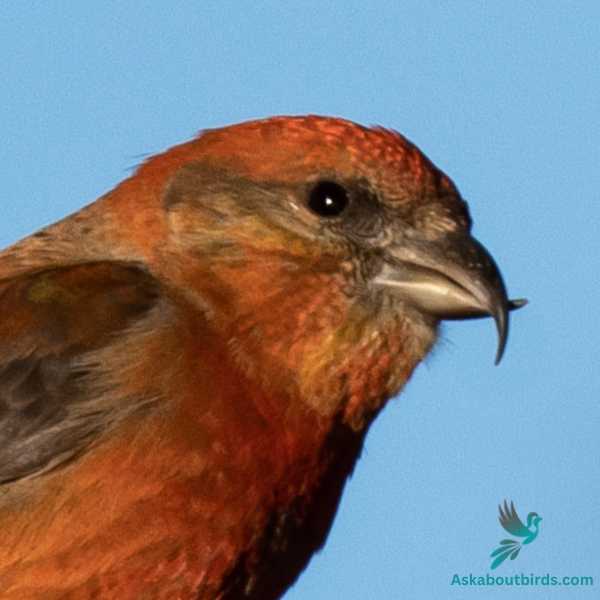

| Feature | Measurement |
|---|---|
| Scientific Name | Loxia curvirostra |
| Length | 20 cm |
| Wingspan | 27–29 cm |
| Weight | 40-53 g |
The Red Crossbill is a peculiar bird species, celebrated for its unique beak structure and vibrant coloration.
Appearance: Red Crossbills are named for their distinctive crossed mandibles, which are adapted to extracting seeds from conifer cones. Male Red Crossbills are usually bright red or orange, while females and juveniles are greenish-yellow. All have dark wings and notched tails.
Diet: The diet of the Red Crossbill is primarily composed of conifer seeds, their unique beak allowing them to access these seeds with ease. This diet includes seeds from pine, spruce, and other types of coniferous trees. They are also known to consume some insects.
Reproduction: Red Crossbills are known for their flexible breeding season, which can occur any time of the year when there is an abundance of food. They typically nest in conifers, where the female lays a clutch of 3 to 4 eggs.
American Redstart


| Feature | Measurement |
|---|---|
| Scientific Name | Setophaga ruticilla |
| Length | 4.3 to 5.5 in |
| Wingspan | 6.3 to 9.1 in |
| Weight | 8.6 g |
The American Redstart is a lively warbler known for its vivid colors and active hunting style, often seen flitting about, fanning its tail to startle and catch insects.
Appearance: Adult male American Redstarts boast striking black plumage with bright orange patches on the sides, wings, and tail. Females and immature males have grayish-olive upperparts with yellow patches in the same areas where the males display orange.
Diet: American Redstarts are primarily insectivores. They actively forage for flying insects, as well as caterpillars and spiders, often using their colorful tails to startle prey and make them easier to catch.
Reproduction: The female American Redstart builds a cup-shaped nest in the fork of a tree branch. Typically, she lays a clutch of 3 to 5 eggs. The female takes on the primary responsibility of incubating the eggs, while both parents participate in feeding the fledglings after they hatch.
Red-bellied Woodpecker
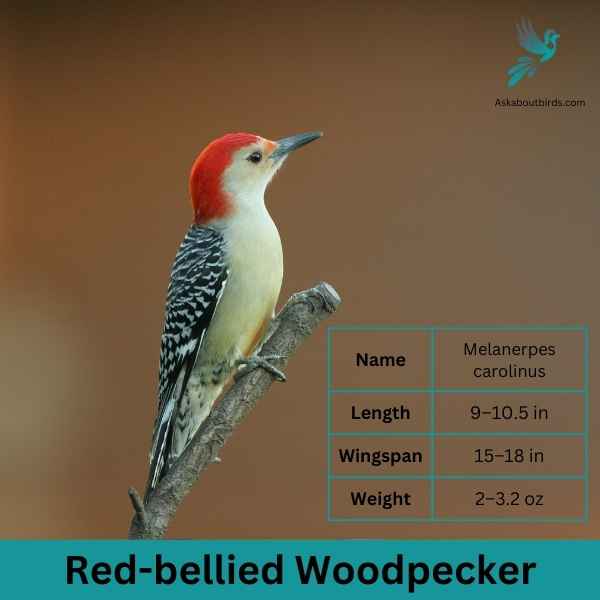
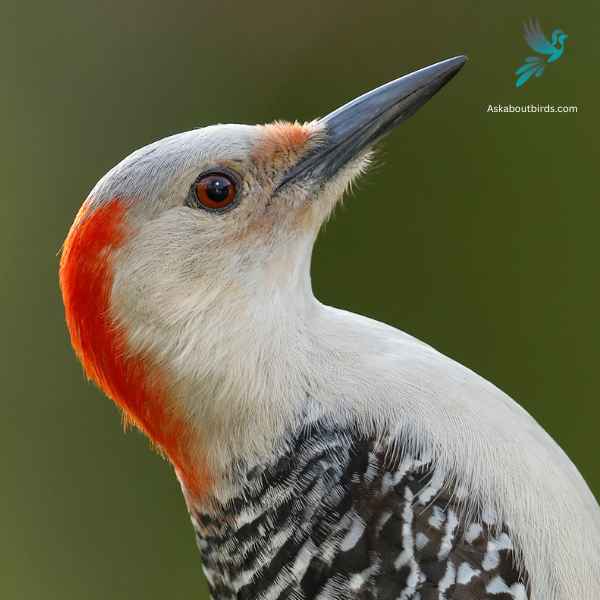
| Feature | Measurement |
|---|---|
| Scientific Name | Thryothorus ludovicianus |
| Length | 4.7–5.5 in |
| Wingspan | 11 in |
| Weight | 0.63–0.81 oz |
The Red-bellied Woodpecker is a medium-sized woodpecker commonly found in woodlands, forests, and backyards across the eastern and central U.S.
Appearance: The Red-bellied Woodpecker sports a pale gray face, throat, and belly, contrasted by a zebra-striped back. Its name derives from the subtle reddish tinge on its belly, but it’s more commonly recognized by the vivid red cap on the head of males and the partial red cap on females.
Diet: This woodpecker has a varied diet that includes insects, fruits, nuts, and seeds. They frequently forage on tree trunks and branches, using their sticky, barbed-tipped tongue to extract ants, beetles, and other insects from crevices.
Reproduction: Red-bellied Woodpeckers are cavity nesters, excavating holes in tree trunks for their nests. The inside of the nest is typically unlined or sparingly lined with wood chips.
Pine Grosbeak

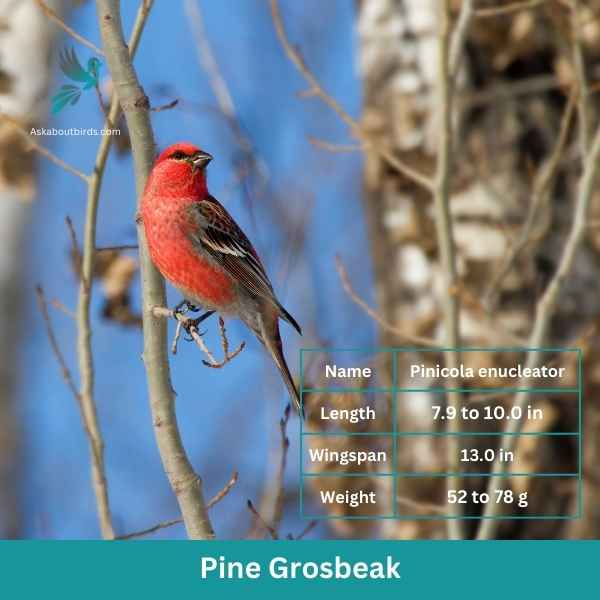
| Feature | Measurement |
|---|---|
| Scientific Name | Pinicola enucleator |
| Length | 7.9 to 10.0 in |
| Wingspan | 13.0 in |
| Weight | 52 to 78 g |
The Pine Grosbeak is a striking bird native to the northern regions of North America, often found in coniferous forests. Both males and females have a plump and robust body with a large beak adapted for eating seeds. The male Pine Grosbeak displays a vibrant reddish-pink plumage, while the female has a more subdued grayish-brown coloration.
These birds are typically seen in small flocks, foraging for food in trees and on the ground. They have a preference for seeds, particularly those from various conifer species. The Pine Grosbeak uses its strong bill to crack open the cones of tall trees and extract the seeds, but they also consume berries and small fruits when available.
Where to Spot Connecticut’s Red Birds
Connecticut’s landscapes offer a treasure trove for bird enthusiasts. Here are the top spots that have captivated me during my avian adventures in the state:
- Hammonasset Beach State Park, Madison: Connecticut’s largest shoreline park, Hammonasset, is a migratory bird paradise, especially during the fall and spring migrations. The coastal habitats here attract shorebirds, waterfowl, and songbirds alike.
- White Memorial Conservation Center, Litchfield: Spread across 4,000 acres, this preserve boasts diverse habitats from forests to wetlands. A haven for nesting birds, it’s particularly known for spotting woodpeckers and finches.
- Sherwood Island State Park, Westport: As Connecticut’s first state park, its coastal location makes it a top spot for waterfowl and shorebirds. The park’s varied habitats also attract songbirds and raptors, especially during migration seasons.
- Bent of the River Audubon Center, Southbury: Nestled in the foothills of the Southern Berkshires, this 700-acre sanctuary is a magnet for migratory songbirds. The meadows, forests, and river corridor offer an idyllic backdrop for birdwatching.
- Great Island Wildlife Area, Old Lyme: A part of the Connecticut River estuary system, this tidal marsh is a top spot for waterfowl, wading birds, and raptors. Its vastness ensures a serene birdwatching experience.
| State’s Red Birds | Top Spots for Red Birds |
|---|---|
| New York’s Red Birds | 1. Central Park, NYC 2. Montezuma National Wildlife Refuge 3. Bashakill Wildlife Management Area |
| Massachusetts’s Red Birds | 1. Plum Island (Parker River National Wildlife Refuge) 2. Quabbin Reservoir 3. Cape Cod National Seashore |
| Rhode Island’s Red Birds | 1. Sachuest Point National Wildlife Refuge 2. Trustom Pond National Wildlife Refuge 3. Block Island |
FAQs on Red Bird Species Found in Connecticut
Which red birds are commonly spotted at backyard bird feeders in Connecticut?
In Connecticut, the Northern Flicker and Rose-breasted Grosbeak are two of the red birds often seen at backyard bird feeders. The Northern Flicker, known scientifically as “northern flicker scientific name”, has a distinctive red patch on its nape, while the Rose-breasted Grosbeak male boasts a bright red plumage on its chest, making them easily recognizable among other birds.
What type of red-throated bird can bird watchers expect to see in Connecticut during the summer?
Bird watchers in Connecticut can look forward to spotting the Ruby-throated Hummingbird during the summer months. These tiny birds, with their distinctive bright red throat or “ruby throat”, are the only hummingbird species that breed in the eastern part of North America. They can often be seen hovering near flower patches or visiting bird feeders, especially those filled with nectar.
What are some identifying features of white-winged crossbills?
White-winged crossbills are distinctive birds with two white wing bars that set them apart from other species. These bars, coupled with their unique crossbill, make them easily identifiable. They are known to visit bird feeders, especially if they offer black oil sunflower seeds, which are a favorite among many bird species.
What attracts ruby-throated hummingbirds to a garden?
Ruby-throated hummingbirds are particularly fond of areas with abundant nectar sources. To attract them to a backyard, homeowners can set up bird feeding stations with sweetened water. These birds are also drawn to yellow-green vegetation, which often indicates the presence of flowers with nectar.

